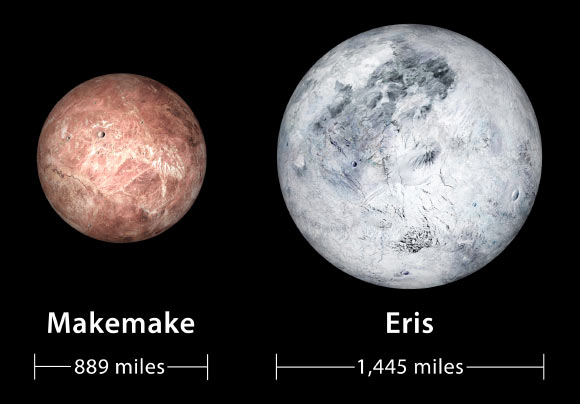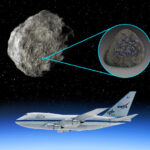The icy dwarf planets Eris and Makemake have surfaces bearing methane ice of unknown origin. According to an analysis of data from the NASA/ESA/CSA James Webb Space Telescope, Eris and Makemake have rocky cores that underwent substantial radiogenic heating and may still be warm/hot enough to make methane.
Glein et al. found evidence for hydrothermal or metamorphic activity deep within the icy dwarf planets Eris and Makemake. Image credit: Southwest Research Institute.
“We see some interesting signs of hot times in cool places,” said Dr. Christopher Glein, a planetary researcher at Southwest Research Institute.
“I came into this project thinking that large Kuiper Belt objects (KBOs) should have ancient surfaces populated by materials inherited from the primordial Solar Nebula, as their cold surfaces can preserve volatiles like methane.”
“Instead, Webb gave us a surprise! We found evidence pointing to thermal processes producing methane from within Eris and Makemake.”
Using Webb, Dr. Glein and his colleagues made the first observations of isotopic molecules on the surfaces of Eris and Makemake.
These so-called isotopologues are molecules that contain atoms having a different number of neutrons. They provide data that are useful in understanding planetary evolution.
The astronomers measured the composition of the dwarf planets’ surfaces, particularly the deuterium (heavy hydrogen, D) to hydrogen (H) ratio in methane.
Deuterium is believed to have formed in the Big Bang, and hydrogen is the most abundant nucleus in the Universe.
The D/H ratio on a planetary body yields information about the origin, geologic history and formation pathways of compounds containing hydrogen.
“The moderate D/H ratio we observed with Webb belies the presence of primordial methane on an ancient surface. Primordial methane would have a much higher D/H ratio,” Dr. Glein said.
“Instead, the D/H ratio points to geochemical origins for methane produced in the deep interior. The D/H ratio is like a window. We can use it in a sense to peer into the subsurface.”
“Our data suggest elevated temperatures in the rocky cores of these worlds so that methane can be cooked up.”
“Molecular nitrogen (N2) could be produced as well, and we see it on Eris.”
“Hot cores could also point to potential sources of liquid water beneath their icy surfaces.”
“If Eris and Makemake hosted, or perhaps could still host warm, or even hot, geochemistry in their rocky cores, cryovolcanic processes could then deliver methane to the surfaces of these planets, perhaps in geologically recent times,” said Dr. Will Grundy, an astronomer at Lowell Observatory.
“We found a carbon isotope ratio (13C/12C) that suggests relatively recent resurfacing.”
“After NASA’s New Horizons flyby of the Pluto system, and with this discovery, the Kuiper Belt is turning out to be much more alive in terms of hosting dynamic worlds than we would have imagined,” Dr. Glein said.
“It’s not too early to start thinking about sending a spacecraft to fly by another one of these bodies to place the Webb data into a geologic context. I believe that we will be stunned by the wonders that await!”
The study was published in the journal Icarus.
_____
Christopher R. Glein et al. 2024. Moderate D/H ratios in methane ice on Eris and Makemake as evidence of hydrothermal or metamorphic processes in their interiors: Geochemical analysis. Icarus 412: 115999; doi: 10.1016/j.icarus.2024.115999




